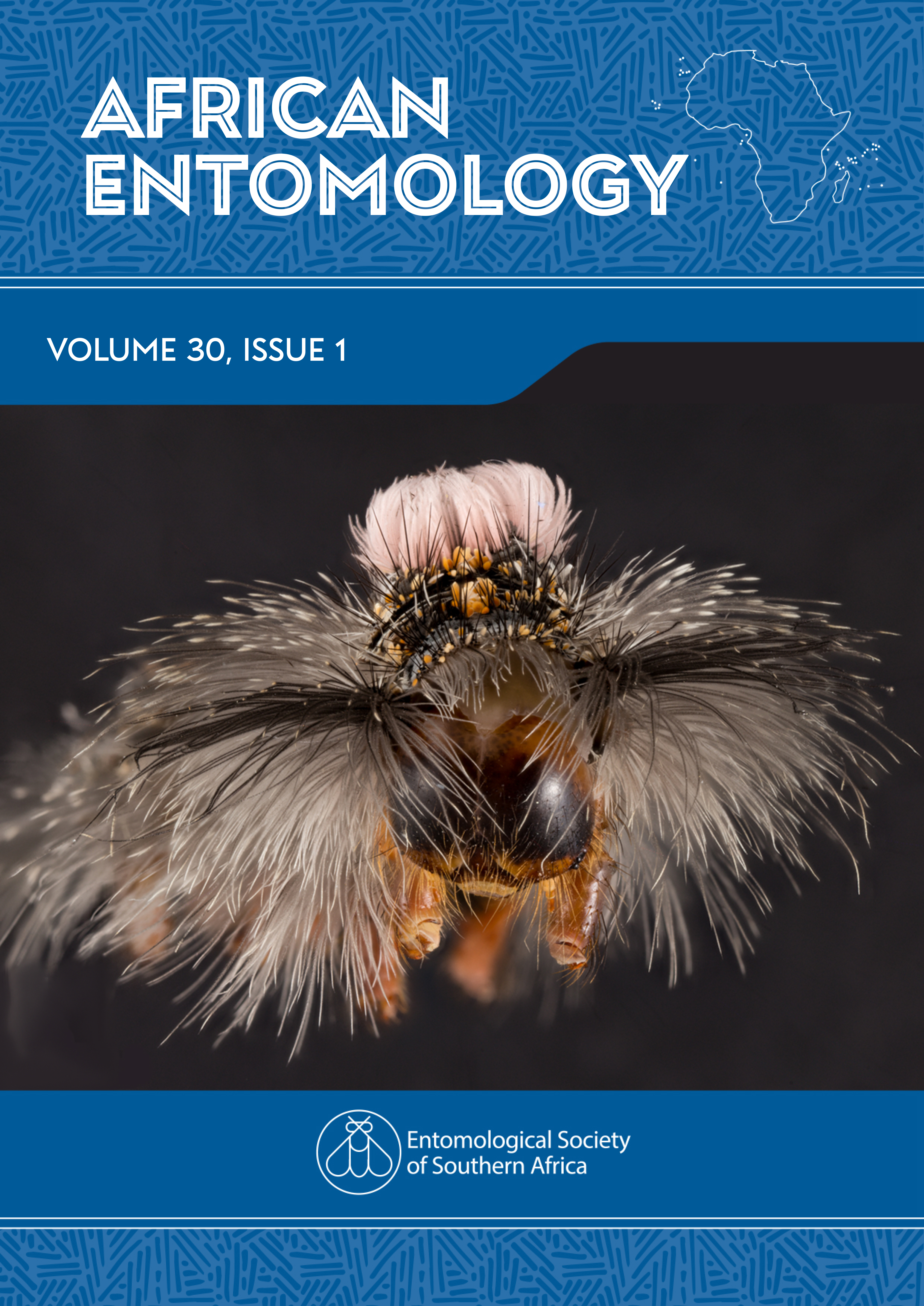Description of the male of Rediviva steineri Kuhlmann, 2012 (Hymenoptera: Melittidae), an endemic oil-collecting bee species from South Africa
DOI:
https://doi.org/10.17159/2254-8854/2022/a11778Keywords:
'genitalia', 'taxnonomy', 'Great Escarpment', 'Apoidea', 'Melittinae'Abstract
We describe the male of Rediviva steineri Kuhlmann, 2012; distinguished by the shape and the margin of the apical plate of the eighth sterna and the vestiture of metasomal terga two and three. Five males were collected at the type locality of the female (Farm Doornbosch, Western Cape, South Africa). We examined the types of three other closely related species (R. pallidula, R. brunnea and R. whiteheadi) and provide images of the eighth sterna for comparison with R. steineri and update Whitehead et al.’s (2008) identification key for the males of these species.
Downloads
References
Kahnt B, Montgomery GA, Murray E, Kuhlmann M, Pauw A, Michez D, Paxton RJ, Danforth BN. 2017. Playing with extremes: Origins and evolution of exaggerated female forelegs in South African Rediviva bees. Molecular Phylogenetics and Evolution 115: 95–105. https://doi.org/10.1016/j.ympev.2017.07.025 DOI: https://doi.org/10.1016/j.ympev.2017.07.025
Kuhlmann M. 2012. Two new species of the South African endemic bee genus Rediviva Friese (Hymenoptera: Apoidea: Melittidae). Zootaxa 3517: 71–78. https://doi.org/10.11646/zootaxa.3517.1.4 DOI: https://doi.org/10.11646/zootaxa.3517.1.4
Kuhlmann M, Jürgensen LS, Michez D. 2020. Subgeneric classification of the bee genus Rediviva Friese (Hymenoptera: Apiformes: Melittidae). Zootaxa 4790: 318–328. https://doi.org/10.11646/zootaxa.4790.2.7 DOI: https://doi.org/10.11646/zootaxa.4790.2.7
Melin A, Altwegg R, Manning JC, Colville JF. 2021. Allometric relationships shape foreleg evolution of long-legged oil bees (Melittidae: Rediviva). Evolution 75: 437–449. https://doi.org/10.1111/evo.14144 DOI: https://doi.org/10.1111/evo.14144
Melin A, Krenn HW, Bowie RCK, Beale CM, Manning JC, Colville JF. 2019. The allometry of proboscis length in Melittidae (Hymenoptera: Apoidae) and an estimate of their foraging distance using museum collections. PLoS One 14: e0217839. https://doi.org/10.1371/journal.pone.0217839 DOI: https://doi.org/10.1371/journal.pone.0217839
Michener CD. 2007. The bees of the world. Second edition. Baltimore: Johns Hopkins University Press.
Michez D, Patiny S, Danforth BN. 2009. Phylogeny of the bee family Melittidae (Hymenoptera: Anthophila) based on combined molecular and morphological data. Systematic Entomology 34:574–597. https://doi.org/10.1111/j.1365-3113.2009.00479 DOI: https://doi.org/10.1111/j.1365-3113.2009.00479.x
Mucina L, Rutherford MC (eds). 2006. The Vegetation of South Africa, Lesotho and Swaziland. Strelitzia, Vol. 19, South African National Biodiversity Institute, Pretoria.
Pauw A. 2006. Floral syndromes accurately predict pollination by a specialized oil-collecting bee (Rediviva peringueyi, Melittidae) in a guild of South African orchids (Coryciinae). American Journal of Botany 93: 917–926. https://doi.org/10.3732/ajb.93.6.917 DOI: https://doi.org/10.3732/ajb.93.6.917
Pauw A, Kahnt B, Kuhlmann M, Michez D, Montgomery GA, Murray E, Danforth BN. 2017. Long-legged bees make adaptive leaps: linking adaptation to coevolution in a plant – pollinator network. Proceedings of the Royal Society B: Biological Sciences 284: 20171707. https://doi.org/10.1098/rspb.2017.1707 DOI: https://doi.org/10.1098/rspb.2017.1707
Steiner KE, Whitehead VB. 1990. Pollinator adaptation to oil-secreting flowers-Rediviva and Diascia. Evolution 44: 1701. https://doi.org/10.2307/2409348 DOI: https://doi.org/10.2307/2409348
Steiner KE, Whitehead VB. 1991. Oil flowers and oil bees: Further evidence for pollinator adaptation. Evolution 45: 1493. https://doi.org/10.1111/j.1558-5646.1991.tb02651.x DOI: https://doi.org/10.2307/2409895
Vogel S. 1984. The Diascia flower and its bee-an oil-based symbiosis in southern Africa. Acta Botanica Neerlandica 33: 509–518. DOI: https://doi.org/10.1111/j.1438-8677.1984.tb01842.x
Vogel S, Michener CD. 1985. Long bee legs and oil-producing floral spurs, and a new Rediviva (Hymenoptera, Melittidae; Scrophulariaceae). Journal of Kansas Entomological Society 58: 359–364.
Whitehead VB, Steiner KE. 1992. Two new species of oil-collecting bees of the genus Rediviva from the summer rainfall region of South Africa, Hymenoptera, Apoidea, Melittidae. Annals of the South African Museum 102: 143-164.
Whitehead VB, Steiner KE. 2001. Oil-collecting bees of the winter rainfall area of South Africa (Melittidae, Rediviva). Annals of the South African Museum 108: 143–277.
Whitehead VB, Steiner KE, Eardley CD. 2008. Oil collecting bees mostly of the summer rainfall area of southern Africa (Hymenoptera: Melittidae: Rediviva). Journal of Kansas Entomological Society 81: 122–141. https://doi.org/10.2317/jkes-703.12.1 DOI: https://doi.org/10.2317/JKES-703.12.1
Downloads
Published
Issue
Section
License
Copyright (c) 2022 Annalie Melin, Jonathan F. Colville

This work is licensed under a Creative Commons Attribution 4.0 International License.
How to Cite
Funding data
-
National Research Foundation
Grant numbers UID127738 -
National Geographic Society
Grant numbers EC-62339R-20;NGS-82264R-20




.png)